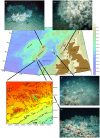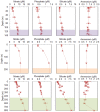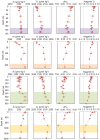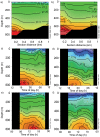Fine-scale nutrient and carbonate system dynamics around cold-water coral reefs in the northeast Atlantic
- PMID: 24441283
- PMCID: PMC3895924
- DOI: 10.1038/srep03671
Fine-scale nutrient and carbonate system dynamics around cold-water coral reefs in the northeast Atlantic
Abstract
Ocean acidification has been suggested as a serious threat to the future existence of cold-water corals (CWC). However, there are few fine-scale temporal and spatial datasets of carbonate and nutrients conditions available for these reefs, which can provide a baseline definition of extant conditions. Here we provide observational data from four different sites in the northeast Atlantic that are known habitats for CWC. These habitats differ by depth and by the nature of the coral habitat. At depths where CWC are known to occur across these sites the dissolved inorganic carbon ranged from 2088 to 2186 μmol kg(-1), alkalinity ranged from 2299 to 2346 μmol kg(-1), and aragonite Ω ranged from 1.35 to 2.44. At two sites fine-scale hydrodynamics caused increased variability in the carbonate and nutrient conditions over daily time-scales. The observed high level of variability must be taken into account when assessing CWC sensitivities to future environmental change.
Figures






References
-
- Dullo W.-C. Coral growth and reef growth: a brief review. Facies 51, 33–48 (2005).
-
- Hennige S. J., Suggett D. J., Hepburn L., Pugsley A. & Smith D. J. Coral reefs of the Wakatobi: processes of reef growth and loss. Marine Research and Conservation in the Coral Triangle: the Wakatobi Marine National Park, Clifton, J., Unsworth, R. K. F. & Smith, D. J. (eds.), 27–44 (Nova, New York, 2010).
-
- Dorschel B., Hebbeln D., Rüggeberg A. & Duloo C. Carbonate budget of a cold-water coral carbonate mound: Propeller Mound, Porcupine Seabight. Int. J. Earth Sci. 96, 73–83 (2007).
-
- Dullo W.-C., Flögel S. & Rüggeberg A. Cold-water coral growth in relation to the hydrography of the Celtic and Nordic European continental margin. Mar. Ecol. Prog. Ser., 371, 165–176 (2008).
-
- Davies A. J., Wisshak M., Orr J. C. & Roberts J. M. Predicting suitable habitat for the cold-water coral Lophelia pertusa (Scleractinia). Deep-Sea Res. I 55, 1048–1062 (2008).
Publication types
MeSH terms
Substances
LinkOut - more resources
Full Text Sources
Other Literature Sources

